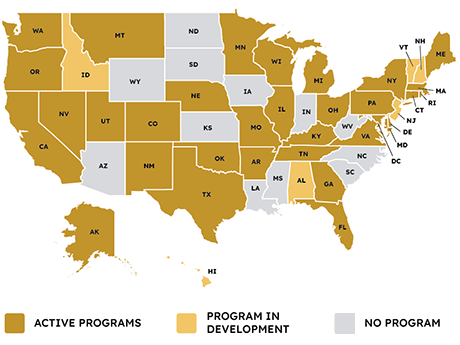It may have taken more than a decade, but after starting out as a niche financing vehicle to create more energy-efficient and resilient buildings, the commercial property assessed clean energy (C-PACE) program has arguably achieved mainstream acceptance.

Roughly 40 states and Washington, D.C., now either offer or are developing C-PACE programs. Over the last year alone, Georgia, Hawaii, New Mexico, Minnesota and Idaho passed legislation enabling or substantially improving the financing tool, points out Rafi Golberstein, CEO of PACE Loan Group, a direct lender of C-PACE headquartered in Minneapolis, Minn. What’s more, he adds, New Jersey and North Carolina are among states that in the coming months are expected to advance bills authorizing the use of C-PACE, or PACE for short.
Given the current partisanship within the country, one of the most revealing characteristics of PACE’s growing appeal has been its ability to cross the political aisle, Golberstein observed. PACE’s popularity in particular has ascended over the last several months as developers have sought fresh capital to enhance their financial flexibility in a rising interest rate environment.
“PACE is really turning out to be a bipartisan issue, as many state lawmakers are realizing that it is a great financing tool for commercial real estate renovations as well as economic development,” says Golberstein, who also is on the executive committee of C-PACE Alliance, a trade group lobbying for the program’s expansion. “It’s refreshing to see state legislatures pick this up, whether they happen to be blue states, red states or purple states. We don’t view a state’s tendency to lean one way or the other as a major hurdle to the program’s expansion.”
In Georgia, for example, new PACE legislation has provided certainty to developers wanting to use the tool in that state. Heretofore, Atlanta had tried to carve out its own PACE program, which created confusion and ambiguity within the metro’s second-ring suburbs where it was unclear whether projects would qualify, Golberstein remarks.
“That was a big legislative win for PACE in 2024,” he says. “Like other Sunbelt states, Georgia is a high-growth market, and we’re very focused on it.”
Rising Awareness
PACE loans feature a fixed interest rate and pay for building upgrades to improve energy and water efficiency as well as seismic resiliency in new construction and rehabs. Depending on the state, it typically finances 25 to 35 percent of a project’s capital stack and amortizes over 20 to 30 years. Unlike conventional senior loans that are secured by the asset, PACE functions as a property assessment that landlords pay with their tax bills, and the loans are transferable and cannot be called.
Those features provide more security than mezzanine financing and preferred equity, which are short-term debt solutions that can have draconian penalties. Additionally, in many cases, developers can pay for qualifying improvements completed over the previous three years. That has become increasingly important amid a growing need for capital to secure refinancings for properties that have yet to stabilize, that have lost value or that are in a state of development limbo.
In June, PACE Loan Group provided a $17.7 million loan to restart the construction of a 136-key Hyatt House hotel and an attached medical rehab annex in West Chester, Ohio, after the project was delayed by the pandemic. The PACE proceeds, which refinanced existing debt, are paying for energy conservation and renewable energy measures that are expected to save $31,620 annually, according to PACE Loan Group.
“The higher interest rate environment has forced owners, developers and mortgage brokers to be open to alternative forms of capital, and PACE has gone from being an esoteric asset class to a tool that is much more understood throughout the capital markets,” Golberstein says. “We’re seeing a larger number of deals where developers are requesting PACE as part of the capital stack.”
PACE Improvements
While states across the political spectrum are embracing PACE, the reasons why differ. PACE proceeds can help states like New York, California and Washington pursue building decarbonization goals, for example. However, in states like Idaho, economic development drove more of the interest in PACE, Golberstein explains.
In some cases, states that passed PACE legislation several years ago are tweaking their programs or have become more assertive in advancing the initiative. Among others, Minnesota originally enabled PACE in 2010, and with 533 PACE deals originating a total of $326 million in loan proceeds through 2023, that state has seen some of the most robust PACE activity in the country, according to C-PACE Alliance statistics.
However, the Minnesota Legislature recently enhanced the program by expanding the loan period to 30 years and the amount of proceeds to 30 percent of a property’s value. Prior to the change, both were set at 20 percent, which hindered deal eligibility. It also broadened building improvements eligible for PACE, including those related to carbon reduction and building resiliency, says Golberstein, who testified in favor of the changes.
“We brought Minnesota more in line with what are becoming national best practices,” he declares. “Those changes will significantly increase PACE productivity in the state because it has been tougher for some deals to pencil financially under Minnesota’s older ‘1.0 version.’ Now we’re onto PACE 2.0.”
— By Joe Gose. PACE Loan Group is a content partner of REBusinessOnline. To learn more about PACE Loan Group, click here, or access their Get a Quote form here.


